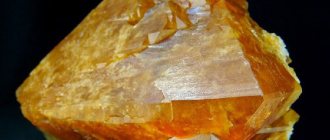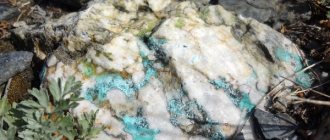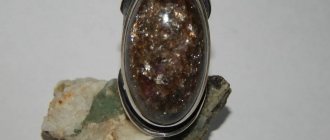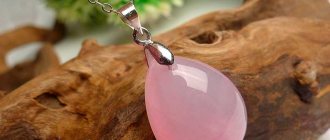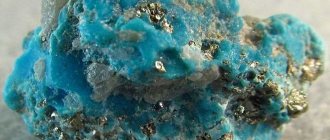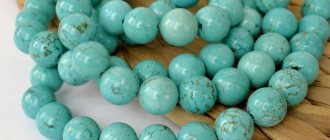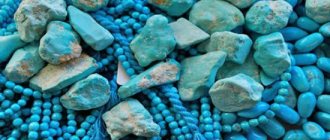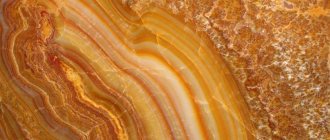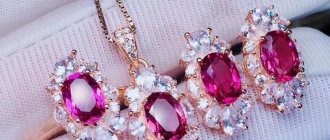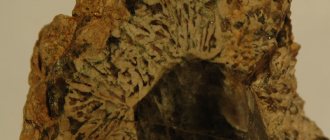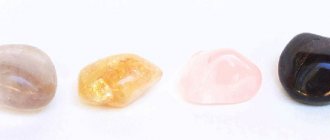During the time of the pharaohs, turquoise was brought to the country from the Sinai Peninsula. And today this place remains a place for mining turquoise and corals. The ancient mines of Wadi Magare (“Valley of Caves”) were described at the beginning of the 19th century by the German explorer Ulrich Jasper Seetzen in his travel notes. The Egyptians called these places “terraces of turquoise.” Thousands of captive slaves were sent to the waterless deserts of Sinai. This is where the cult of this stone began.
Turquoise was widely used in Egyptian jewelry, as evidenced by the mask and sarcophagus of Pharaoh Tutankhamun, whose burial archaeologists say was not the richest, although countless jewelry was found in the tomb, including with turquoise, for example, a chest decoration - a golden falcon , inlaid with turquoise and other precious stones. A turquoise scarab beetle was also found here. The Egyptians often carved such beetles, which were considered sacred, from turquoise; they served as amulets and were recognized as the most powerful in their magical powers.
A turquoise scarab beetle is the most common souvenir that you can bring as a souvenir of your trip to Egypt.
Turquoise was admired not only in Egypt. After the decline of the great Egyptian civilization, the ancient mines in Sinai were forgotten, but turquoise came to Europe from Persia (now the territory of Iran). Until now, in Iran, turquoise is considered almost a national talisman stone. The country's income from stone mining was an important part of the economy.
In Ancient Iran, turquoise was valued higher than gold. It was available only to the noble and rich. Jewelery connoisseurs say that the Shah's treasury of Iran contains a unique collection of turquoise, including the tiara of the Iranian Empress Farah Pahlavi.
In Europe, turquoise was called the “Turkish stone”. This is because many trade branches of the Great Silk Road ended in Turkey, from here ships from the East to Europe carried goods to Italy and France.
Turquoise was also considered a sacred stone among the Indians of the American continent. Large and ancient turquoise mines have been discovered in North America. As a result of excavations in the Chaco National Historical Park, archaeologists discovered tens of thousands of turquoise items. The burial of Aztec leaders was always accompanied by a huge amount of turquoise. Therefore, it is not surprising that such burials contained numerous and interesting finds.
Today, turquoise from Iran continues to be famous throughout the world. Turquoise from Arizona can compete with it. Good quality turquoise is mined in Afghanistan and Central Asian countries (Tajikistan, Uzbekistan, Kazakhstan). Turquoise deposits exist in the Caucasus, Mongolia, Israel, Ethiopia, Chile, Australia, China, and Russia.
The word "turquoise" comes from the Persian words "firuze" ("stone of happiness") and "piruz" (victory, winner). In Arabic, Firuzaj means “victorious.”
History and origin
The history of the gem dates back five thousand years. The sky-colored mineral among ancient peoples symbolized the supreme deity. Other myths claim that turquoise is the bones of people who died from unhappy love.
Turquoise
The oldest objects made from the mineral were discovered in the tombs of the rulers of Ancient Egypt - Queen Zara and Tutankhamun. Turquoise was used to decorate jewelry, amulets or amulets. For example, the warlike Janissaries decorated themselves, weapons and horses to make themselves invulnerable.
The mineral is highly valued in Tibet: here it is a jewel and currency. The properties of turquoise to fade and change color attracted the attention of shamans and sorcerers: they used the stone for fortune telling. The Chinese use it to prove their devotion and loyalty to their significant other.
Turquoise light stones decorated the throne of Boris Godunov, delivered from Turkey: sitting on it, the sovereign calmed down. Ivan the Terrible demonstrated to the ambassadors and entourage how the stone changed color in his hands. The court doctors explained to the king what this meant.
The stone has a special significance for the Muslim world: the Koran is inscribed on blue turquoise.
Turquoise became known to Europeans as the “Turkish stone”; in Russia the Persian name stuck. The mineral acquired its classical name in the 13th century. It is translated differently: “firyuze” is a stone of happiness, “piruz” is a mineral of winners.
Turquoise stone
Interesting facts about turquoise:
- Turquoise was very highly valued in Ancient Egypt. Sacred scarab beetles were carved from it and served as amulets and cult objects. The Egyptians mined turquoise in the arid deserts of the Sinai Peninsula. Pharaoh sent many thousands of captives and slaves to these difficult jobs.
- Interestingly, turquoise was no less popular on the other side of the Atlantic Ocean. The Aztecs made ritual masks from it, which have survived to this day.
- At all times, turquoise has been considered a symbol of health, happiness and good luck. It is recognized as the stone of daredevils and brave men, a conductor of higher powers, and warriors in ancient times decorated the hilts of their swords with this mineral in order to become invincible.
Physicochemical characteristics
Turquoise is a blue, white or green gem with shades. Color is created by copper or iron. If there is more copper, green shades are obtained, if iron, blue shades are obtained.
Structurally, it is not a crystal, but an agglomerate. Semi-precious or ornamental stone.
| Property | Description |
| Formula | CuAl6(OH)2[PO4]4H2O |
| Color | Blue, light blue, blue-green, green, often with brown spots. |
| Shine | Wax |
| Transparency | Opaque |
| Hardness | 5-6 |
| Cleavage | Perfect/imperfect |
| Kink | Conchoidal, uneven. |
| Density | 2.6-2.8 g/cm³ |
Place of Birth
The oldest are the Sinai and Nishapur mines. America is currently the leader in fossil fuel production. Active mines in Nevada, Arizona, Mexico. Fossil fishing is carried out in Armenia, Afghanistan, Tanzania, Argentina and Australia.
Deposits in Egypt are famous for their production of deep blue turquoise, and Brazilian gems differ from other types in their porosity. In Tibet, green turquoise is mined, which is popular among the population. In Central Asian countries, Tajikistan, Turkmenistan, Uzbekistan, semi-precious, ornamental stone is mined.
Varieties and colors
The description of the turquoise stone includes three basic colors plus their shades. The color changes over time: a young stone is bluish, but as it ages, it turns green.
Colors
The color range of the mineral is extensive. Colors range from bluish to bright blue or from barely green to olive.
Main colors of turquoise:
Blue
Rare, most refined color. What makes the gem dazzlingly bright is the absence of iron or the predominance of copper. This structure creates the strength of the stone. Therefore, blue turquoise is often used for jewelry. The most popular color is soft blue. Shade options: blue-blue, greenish-blue, light blue.
Turquoise blue
Green
The color is created by significant iron impurities. It has a waxy sheen, sometimes with uneven color and dark veins. This is the color of old or Chinese stone; attribute of elderly people; loved by the people of Tibet and Mongolia. Options: light green, gray-green.
Green turquoise
White
A teenage stone whose maturation, or pigmentation, is just beginning. Due to the porous structure, white turquoise is of no interest to jewelers, but is held in high esteem by collectors.
Bracelet with white turquoise
Varieties
Light-colored specimens with patterns on the surface are often found. They are created by a combination of copper, chromium, manganese and iron.
- Mesh turquoise. Specimens with solid dark (black or brown) veins. Their chaotic intersection creates a harmonious pattern. Other names are lace or cobweb.
- Bone turquoise. Bone or dental phosphate of large fossil mammals, colored turquoise. Used as an imitation of natural stone. Distributed in Siberia, in the south of France. Rarely available for sale, after high-quality processing it becomes a valuable material.
There is a classification by deposits:
- Arizona - an expensive mineral with a dark pattern, mined in the US state of the same name;
- Iranian - pale blue, premium quality;
- Chinese - green turquoise.
The unique ability of turquoise of any kind is to live an almost human life. A stone can be young, mature or old.
Medicinal properties
The healing properties of the mineral are manifested in the physical and spiritual spheres.
Amulet with turquoise
Physical ailments
The stone has a healing effect in several areas:
- mental problems, insomnia (a gem under the pillow helps);
- headaches, migraines (beads, necklace);
- diseases of the heart, blood vessels (pendant, pendant);
- gastrointestinal disorders, including ulcers (long beads);
- diseases of the liver, gall bladder (long beads);
- stuttering (earrings, pendant);
- colds, sore throat (beads);
- problems with the thyroid gland (pendant).
The gem heals wounds, removes traces of scars, and stops bleeding. A gold bracelet with a stone on the right hand restores immunity.
Not suitable for angry, envious, greedy or depressed people.
Spiritual help
Turquoise harmonizes mood, balances emotions, cleansing and restoring energy:
- Makes a person kinder, helps to get rid of the desire for revenge, teaches to forgive.
- Restores peace between those who have quarreled, helps to understand the cause and eliminate it.
- Helps you cope with thoughts about past sins and not regret anything.
To go through life without doubt, a dark blue rich stone is worn not on the body, but close to it: in a bag or wallet.
Shamballa bracelet with turquoise
A pale blue gem will establish inner harmony.
Health indicator
Even the ancient Mongols determined the state of human health by turquoise. If the stone begins to fade for no reason, the person has an illness or fever. This is not due to magic, but to the natural qualities of the gem. Turquoise reacts to increases in temperature or moisture levels by changing color.
What is a mineral?
Turquoise is a very unusual mineral; it is credited with the property of variability, like a living organism:
- Birth - the appearance of turquoise occurs as a result of hydrothermal or supergene alteration at temperatures of 80-180°C, often in zones of copper deposits with signs of secondary alteration.
- Youth - during this period the stone has pale blue or white shades.
- Maturity - the stone acquires rich colors: bright blue and turquoise.
- Old age and death - at the end of life it can acquire greenish or gray or even brown shades.
It turns out that this stone seems to live its whole life, changing over time, like all living things.
The properties of turquoise are specific and varied; the color inversion of the mineral is the most interesting and mysterious. According to scientists, it all depends on changing the chemical formula, because this mineral is able to absorb fats and moisture. The opinion of folk healers is that the stone diagnoses the health status of its owner.
We also recommend reading:
The history and curse of the Kohinoor stone The marvelous ametrine stone Characteristics of larimar and its main properties Selection of stones by date of birth
During the Middle Ages, the mineral was called the butcher's stone. This is due to the fact that representatives of this profession had the brightest and richest shades of this stone. This observation was later applied for practical purposes to improve the quality of turquoise color.
The properties of turquoise are specific and varied
Magic properties
The magical properties of the stone have been known since the 4th millennium BC. They manifest themselves on the physical and mental levels.
Bracelet with turquoise
Are common
Modern esotericists and sorcerers highlight the following magical properties of natural turquoise:
- Amulet. In the East, children's amulets are made from gemstones. Adults wear a ring or ring: they believe that jewelry will protect them from evil entities and bring good luck.
- Indicator of the body's condition. The stone loses its brightness after the death of the owner: it seems to go out with him. The shine is restored when a new owner is found.
- Relationship marker. A mineral that has changed color signals betrayal of a girlfriend (boyfriend), betrayal of a partner, imminent separation or quarrel.
- Spiritual contact. The gem is able to communicate with the owner at the subconscious level; jewelry and amulets will develop the gift of foresight and attract inspiration.
A ring or ring with turquoise is bought to attract happiness, love, material wealth or spiritual perfection.
However, the magic of the mineral helps only those who pursue good goals and achieve results honestly.
- Leadership. The amulet helps you get along with management, climb the career ladder, and become a boss yourself. Will protect you from mistakes. Greenish turquoise is suitable as a gift for a manager. A stone of this shade brings wealth.
- Guardian of loyalty. If a woman puts a pebble in a man’s pocket or gives a keychain with turquoise, the magic of the stone guarantees strong love. A little thing with a mineral from a loved one will bring success to a girl in matters of the heart and profession. In the Muslim world, jewelry with turquoise is still a mandatory attribute of a bride’s wedding dress.
- Stone of courage. This is a talisman for people in dangerous professions or those who are brave in life.
Bracelet with blue turquoise
Turquoise darkens before bad weather and fades in the hands of a sick person.
Color Specialization
Magical compatibility also depends on the color of the gem:
- light shades - give hope, bring harmony and peace;
- dark colors help to choose a path in life and make decisions; suppress temperament, thirst for power; allow you to adapt to new things and not be afraid of the unknown;
- green - light will smooth out emotions and give confidence in upholding a personal opinion; dark green cannot be worn all the time;
- dark blue - will make the owner patient, self-possessed in any situation;
- pale blue - such turquoise has a special meaning for girls of marriageable age or young women; a stone is required in the attire of Muslim brides;
- blue - guarantees success in business, happiness in the family hearth; how a gift shows the sincerity of the giver;
- blue-green - an attribute of magicians or sorcerers in manipulating the other world, not recommended for ordinary people;
- white is a talisman for extreme sports enthusiasts, a talisman for people in dangerous professions.
The strongest magical properties of turquoise are dark blue, almost blue.
Talismans and amulets of all colors relieve fatigue or stress and help to realistically assess reality.
Who is suitable according to their zodiac sign?
Astrologers are unanimous about which zodiac signs benefit from the gem.
It is believed that turquoise does not suit everyone's zodiac sign.
According to the horoscope, choose a pebble of its color:
- blue - Sagittarius, Aquarius, Gemini;
- green - Scorpio, Taurus;
- white - Pisces, Aries, Virgo.
For the rest of the zodiac sign, a mineral of bluish-gray shades is suitable. According to astrologers, turquoise is contraindicated for Leo: its help is more likely to harm. The pebble may be suitable for the month of birth: February - dark blue stone, March - blue, July - green, August - any.
| Zodiac sign | Compatibility (“+++” – fits perfectly, “+” – can be worn, “-” – strictly contraindicated) |
| Aries | + |
| Taurus | +++ |
| Twins | + |
| Cancer | + |
| a lion | — |
| Virgo | + |
| Scales | + |
| Scorpion | + |
| Sagittarius | +++ |
| Capricorn | + |
| Aquarius | + |
| Fish | + |
(“+++” – fits perfectly, “+” – can be worn, “-” – is strictly contraindicated)
Where is it used?
The only sphere of use of stone is the kingdom of beauty. It is classified as jewelry or decorative.
Jewelry
Turquoise is a universal gem; there is a suitable shade for men and women of any age.
The fragile gemstone is difficult to process, so the impact is minimal. It is turned into a cabochon for rings, rings, earrings, brooches, or left in fancy shapes for beads, bracelets, and pendants.
Bracelet with turquoise
Decor
The mineral is used to decorate tableware, watches, and pens. Small plastics are made from it. The most popular products made from turquoise are scarab beetles. They are most often counterfeited.
Price
The price depends on the properties and purity of the stone. The most expensive is a dense blue specimen without “mesh” or veins, up to $30 per carat (or $150 per gram). Porosity, spotting, patterning or yellowing will reduce the value. The smallest bead costs at least 40 rubles.
Form
In nature, stone is not found in large masses, because it is formed as a result of washing in rock cracks. As a rule, it is obtained in small patches of up to two centimeters, but in rare cases the size can reach five centimeters. If a larger size turquoise is used in the finished product, then it is not real.
The nuggets weigh several tens of kilograms, but only certain sections are used in jewelry; the rest of the mass is a mineral aggregate with minerals replacing the stone.
How to spot a fake
The ancient Egyptians knew how to counterfeit turquoise. They melted glass, earthenware, and fossils, adding pigments. They were not afraid to put imitations even in the tombs of the pharaohs.
The difference between turquoise and fake
Today they offer plastic, ceramics, bone or glass instead.
It is difficult to visually distinguish a real stone from a fake.
The following signs will help you identify fake turquoise:
- A standard pebble is never larger than half a centimeter.
- Description of turquoise: very dense, massive, opaque, with a matte sheen.
- The surface of the natural mineral is rough, but without cracks or swelling. In glass or earthenware, inclusions and swellings are visible under a magnifying glass. The plastic looks smooth, evenly colored, and is almost weightless.
- Turquoise is easy to scratch with a needle, but the groove will be the same color as the surface. If an unpainted layer is detected, shavings have formed, or the needle jumps off the crystal, this means it is a fake. When scratching earthenware, the needle becomes dull.
- Natural stone is difficult to chip.
- The color of the stone should be the same on the beads and in the hole.
- A hot needle will only turn the natural mineral brown, the plastic will melt, and it will emit a chemical smell.
- If you dip the sample in alcohol and then wipe it, the remaining color on the napkin will indicate a fake.
- Imitation “Neolithic” or “Viennese turquoise” is revealed by hydrochloric acid. It will cause yellow spots to appear. Natural mineral will not react.
There is turquoise on the jewelry market, which occupies an intermediate position between natural stone and imitation:
- Fortified. Porous minerals of medium quality, impregnated with paraffin, fat or epoxy resin. The color remains the same, but the stone becomes stronger.
- Ennobled. Dyed, low-grade turquoise stones are identified by their smooth surface and bright color (usually apple green or pink).
- Restored (or pressed). Substandard powdered or low-grade material, painted and glued.
Jewelry with such stones is affordable; most of them are on the market.
Any inspection should be carried out from the inside of the product so as not to damage the stone. Testing with heat is problematic: natural stone can crack along the veins.
Artificial stone is made in a laboratory. Only an expert can identify nanoturquoise. Jewelry made from natural material is supplied with a quality certificate. The deposits of the stone are depleted, so it is never cheap.
The duplicate stones that are being used to replace turquoise are, without a doubt, in many ways inferior to it
Indeed, there are many stones sold under the guise of turquoise. Most often, inexperienced buyers are offered chalcosiderite, aluminochalcosiderite, raschleite, fostite (faustite), vardite, variscite, chrysocolla, dontolite, stellarite, etc. Many of them are really inferior to turquoise. For example, colored howlite (silicoborocalcite) is much brighter, lighter and softer than turquoise. Often offered by American suppliers, quartz and colored chalcedony are clearer and have lower density. But some of the “understudies” have pretty good characteristics. For example, turquenite is a completely worthy substitute for blue stone (the deposits of which have been greatly depleted as a result of thousands of years of development), and in some characteristics it surpasses even refined turquoise. It does not crack when heated, does not change color, and is not afraid of water and light. In essence, turquenite differs from bluestone only in its porcelain shine (as opposed to the waxy or silky shine characteristic of natural turquoise).
How to wear and care
This is a sophisticated but democratic gem. Jewelry with it is popular both in a wedding dress and as “baubles”.
Ring with turquoise
How to wear
Blue shades of stone are good with white metals, green ones with yellow ones. The monochrome range is diluted with pearls, amber, garnet, lapis lazuli, aquamarine, and other colored stones.
- Turquoise looks best on light, natural clothing.
- It is undesirable to combine green and blue stones, white and yellow frames in one outfit.
- Light-colored stones should be worn by green-eyed or blue-eyed people; darker and more saturated ones are suitable for brown-eyed people.
A silver frame enhances the healing properties of the mineral; jewelry with gold is a powerful protector of the owner’s immune system.
If you have handicraft skills, you can create something exclusive by embroidering it with turquoise, for example, jeans or a clutch.
Rules of care
Turquoise, as a delicate mineral, requires care, but care is not particularly tedious:
- Do not clean with soap and water, steam or ultrasound. Only dry clean with suede, wool, flannel or other soft cloth.
- If dirt has accumulated, you can wash the jewelry in distilled water without delaying the procedure.
- Proper care eliminates overheating, contact with steam, cosmetics, perfumes (perfume can leave a mark). Contact with cosmetics or household chemicals causes the mineral to turn green or blue. You can restore its color at home using aniline dyes.
Necklace with turquoise
To preserve the richness of the color, turquoise is sometimes smeared with lamb fat.
- Before taking a bath, pool or beach, jewelry is removed.
- To prevent the stone from losing its magical properties or being physically damaged, it is stored separately from other jewelry and metals.
- Jewelry is sometimes taken out of boxes. Turquoise loves light, but will fade in direct sun.
The stone absorbs odors and sweat, changing color.
Caring for stone products
Natural turquoise is photosensitive; if exposed to direct sunlight, it can fade. The mineral reacts to heat and changes color, so it is better not to expose it to steam and high temperatures. To remove contaminants, you should choose delicate methods. It is best to do this with a soapy solution under running water.
Dry away from heating devices, wipe with a soft cloth. The density of the stone is low, it is easily scratched by other objects and breaks off. Therefore, handle it with care, do not hit or drop it. Store in a case to avoid contact with metal and other crystals.

